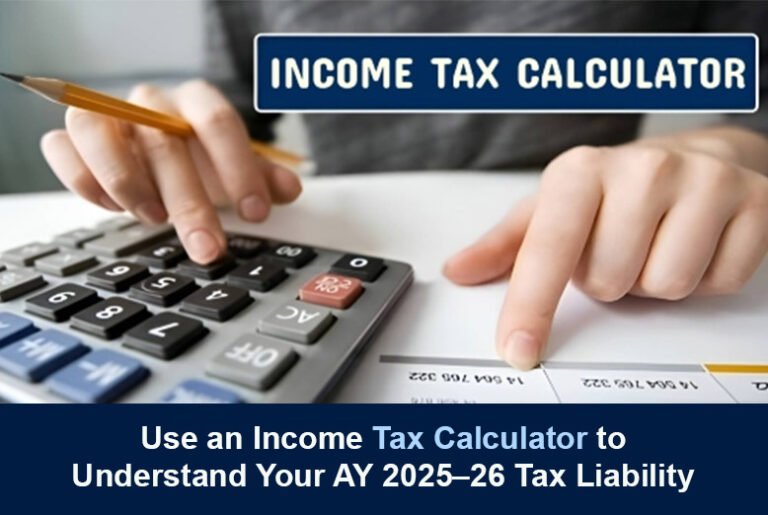Understanding how much tax you owe shouldn’t feel like a guessing game, especially when the rules have changed. With the new tax regime being the default for FY 2024–25 (AY 2025–26), knowing exactly how your income fits into the latest income tax slab for AY 2025–26 is essential.
But here’s the thing: even though slab rates are public knowledge, calculating what you owe isn’t always as simple as checking a chart. That’s where a good income tax calculator helps. It takes into account deductions, rebates, standard deductions, and surcharges, so you’re not stuck figuring it out line by line. Let us take a closer look at the slab structure, starting with the new tax regime and how it compares to last year.
What’s Different in AY 2025–26
Earlier, many salaried individuals opted for the old regime because it allowed multiple deductions. But the new regime now offers a standard deduction of ₹75,000, a benefit that wasn’t always part of the default structure. This change has started to tip the scales.
If you’re unsure which tax regime works better for you, a calculator built for the new regime can give clarity. It does the math in minutes, comparing your post-deduction liability under both structures. That means fewer assumptions and more confidence at filing time.
Let’s take a quick look at how the new slabs compare with the previous year.
| Annual Taxable Income | New Regime (AY 2025–26) | New Regime (AY 2024–25) |
| Up to ₹3,00,000 | Nil | Nil |
| ₹3,00,001 to ₹6,00,000 | 5% | 5% |
| ₹6,00,001 to ₹7,00,000 | 5% on income over Rs. 3L | 10% on income over ₹6L |
| ₹7,00,001 to ₹9,00,000 | ₹20,000 + 10% over ₹7L | ₹25,000 + 10% over ₹7L |
| ₹9,00,001 to ₹10,00,000 | Same as above | ₹45,000 + 10% over ₹9L |
| ₹10,00,001 to ₹12,00,000 | ₹50,000 + 15% over ₹10L | ₹55,000 + 15% over ₹10L |
| ₹12,00,001 to ₹15,00,000 | ₹80,000 + 20% over ₹12L | ₹90,000 + 20% over ₹12L |
| Over ₹15,00,000 | ₹1,40,000 + 30% over ₹15L | ₹1,50,000 + 30% over ₹15L |
These shifts might seem subtle at first, but for many, especially those earning ₹6–9 lakh annually, the difference in tax outgo could be noticeable. Even more so when combined with the new standard deduction.
Standard Deduction: A Quiet Boost to Your Tax Planning
Earlier, only old regime filers enjoyed a standard deduction. Now, that same benefit applies to those choosing the new structure too. It has increased from ₹50,000 to ₹75,000 as announced in Budget 2024. It means salaried individuals get an automatic reduction on taxable income, no paperwork or proofs needed.
Using an Income Tax Calculator: How It Helps
At this point, it’s clear that the income tax slab for AY 2025–26 offers some new advantages. But if you still aren’t sure where you stand, the calculator is your best friend.
A well-designed income tax calculator lets you:
- Check your net tax liability under both regimes
- Factor in deductions like HRA, 80C, 80D (for old tax regime)
- See if you’re eligible for rebates under Section 87A
- Understand the impact of surcharges if income exceeds Rs. 50 lakh
You don’t need to be a tax expert to use one. Just enter your age, income, and deductions. In seconds, you’ll see exactly what you owe and whether it makes sense to stay in the default new regime or switch to the old one manually.
Some insurers and tax platforms have updated their calculators to reflect the 2024 Budget changes. Providers like Axis Max Life Insurance now offer versions that also factor in life insurance premiums and deductions under 80C (only under the old tax regime), which is helpful if you’re using term plans or ULIPs as part of your financial planning.
When To Use Old Regime
Even with the new regime being the default, the old tax structure hasn’t been phased out. In fact, it still offers strong advantages for certain taxpayers, particularly those who:
- Claim home loan interest
- Have large investments under Section 80C (like PPF, EPF, ELSS)
- Claim deductions for HRA, LTA, or health insurance premiums
The reason many stick with the old structure is flexibility. You build your deductions around your lifestyle. If your yearly deductions cross ₹2–2.5 lakh, switching to the old regime might still work in your favour.
But these choices are often best made with hard numbers, not assumptions. That’s exactly where an updated calculator steps in. It helps you compare both outcomes side by side so you can see where you save more.
Surcharges and Rebates
The new regime keeps surcharge rates simpler. Even for high-income earners, the maximum surcharge is capped at 25%, unlike the 37% in the old regime. For someone earning over Rs. 5 crore, this alone could lead to significant savings.
And let’s not forget the rebates under Section 87A. If your income is up to ₹5 lakh under the old regime or ₹7 lakh under the new, your net tax liability could be zero. That makes it crucial to check your final taxable income before filing.
Again, the income tax calculator makes this simple. It applies the latest slab rates, rebates, cess, and deductions, so your outcome is precise, not approximate.
Choosing the Right Regime in AY 2025–26
If you’re still weighing both structures, start by understanding your gross income and list down your eligible deductions. Feed these into the calculator, many updated versions even let you toggle between regimes with one click. That’s where the income tax calculator becomes more than just a math tool.
For someone aged 35 earning ₹12 lakh annually, with ₹1.5 lakh under 80C and ₹25,000 under 80D, the old regime might offer more value. But someone with fewer deductions may find the new regime’s straightforward slabs and standard deduction of ₹75,000 more attractive.
Your age, income, and deductions all play a role in what works best. That’s why it’s not just about knowing the income tax slab for AY 2025–26, but also understanding how that slab interacts with your actual numbers.
Final Thoughts
Taxes are personal. What works for your colleague or friend may not work for you. With changes in slab rates and deductions, AY 2025–26 demands a closer look and a smarter way to evaluate your options.
Using an income tax calculator is no longer optional. It helps you stay updated, reduces your filing stress, and shows you exactly where you stand. The sooner you plug in your numbers, the sooner you’ll know where you save more. In a year full of updates, clarity is your best financial asset.
Standard T&C apply
Insurance is the subject matter of solicitation. For more details on benefits, exclusions, limitations, terms and conditions, please read the sales brochure/policy wording carefully before concluding a sale.
Disclaimer: The content on this page is generic and shared only for informational and explanatory purposes. It is based on several secondary sources on the internet and is subject to changes. Please consult an expert before making any related decisions.
Tax benefit is subject to change as per prevalent tax laws.
Also Read: Understanding the ULIP Calculator: How It Works and Why You Need It



